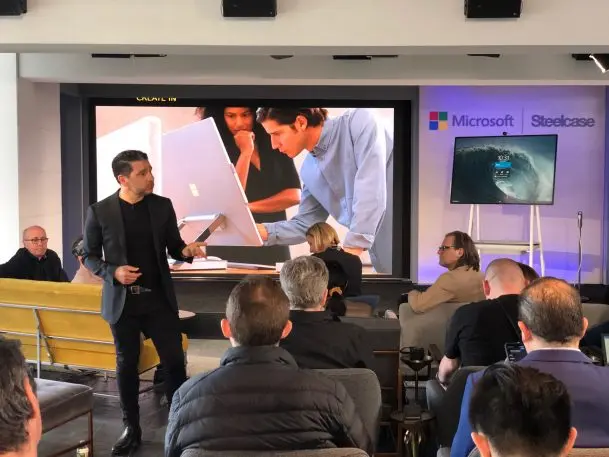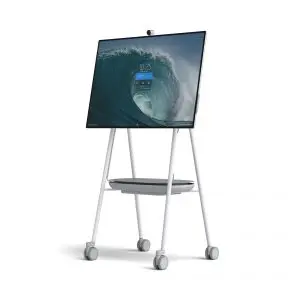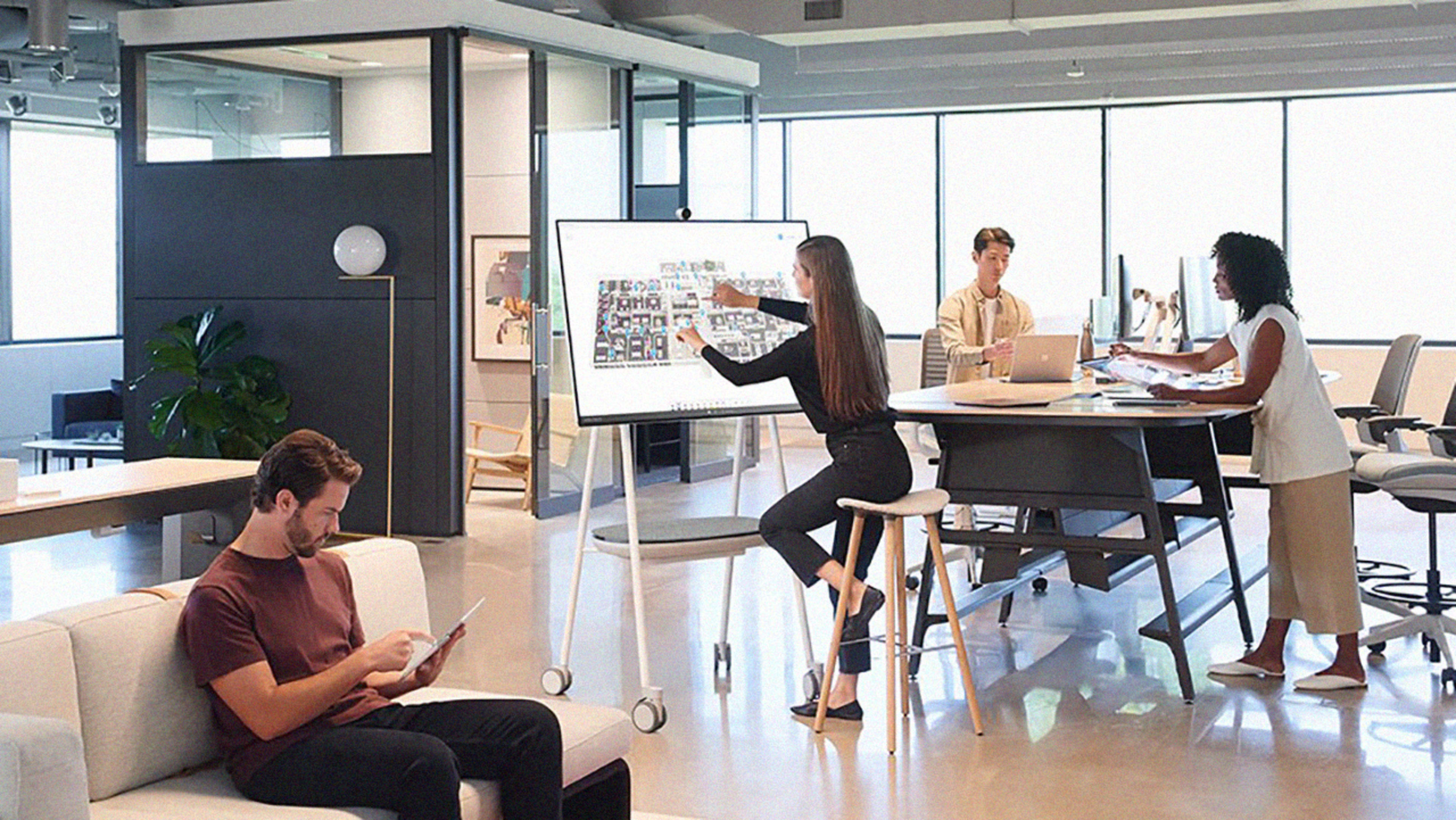The next version of Microsoft’s Surface Hub collaborative display—a giant-sized touch screen powered by Windows 10 and software for tasks such as videoconferencing and whiteboarding—is not due until June. But Microsoft has already spent more than a year whetting the world’s appetite for it, a little bit at a time. In March of 2018, it confirmed that there would be a second-generation Surface Hub. A couple of months later, it teased the upcoming device with a splashy video showing that it looked a lot more like a giant-sized tablet than the first version, including the ability to rotate it into portrait orientation (and even treat multiple portrait-mode units as one huge display).
On Wednesday, Microsoft held a Surface Hub media event at the New York showroom of office furniture maker Steelcase, which is building a rolling stand for the new version of the screen. It revealed more details, including the June release date—though that’s for a version of the Surface Hub 2S running the current software, with updates to arrive in 2020. It also showed off an external battery that can power the Surface Hub for up to two hours, giving team members the ability to use the screen anywhere in an office, including moving it on a whim without powering down and booting up.
The Surface Hub family is also expanding. Later this year, Microsoft plans to sell a version of the 50.5-inch Surface Hub 2 that’s just a pen-enabled screen, for companies that would rather provide their own PC. In 2020, the company will add the Surface Hub 2X, which packs more powerful components and enables the rotation feature. Early next year, it will also begin field testing an even more jumbo-size 85-inch version of the Surface Hub 2S, a tad larger than the bigger of the two original Surface Hub versions.
After the official presentation, I caught up with Panos Panay, the chief product officer for Microsoft’s devices group and the man synonymous with the entire Surface line, from tablets to headphones. He told me that Microsoft wanted the Surface Hub 2S to be amazing—but in a natural, understated way.
The company asked itself, “how do you keep it disappearing into the background beautifully, but give that versatility and mobility that’s needed, and a little bit of magic?,” he says. “So if you have a Surface Hub 2S in your offices and you unplug it, a person with you will be inspired by that alone. And you don’t have to explain how or why it happened. It just did. That’s part of the flow of the product.”

What’s the rush?
The slow-roll debut of the Surface Hub 2S might be atypical, but it’s been smoother than the launch of the first Surface Hub, which involved multiple delays (and a $2,000 price hike after the product had been announced). With the 2S, according to Panay, Microsoft is comfortable erring on the side of shipping something good rather than hitting a timetable. “We could have made trade-offs and shipped it six months earlier for sure, but that’s not what we’re about,” he says. The big companies who are prime Surface Hub customers, he adds, don’t object to hearing about products long before they hit the market or waiting for a software upgrade.

With its minimal bezel and thin profile, the Surface Hub 2S is a major step forward designwise: “There’s something very modern about slim,” says Panay. “There’s something very modern about sleek and light.” It’s not just about aesthetics, though. The original Surface Hub was bulky and heavy enough that wall-mounting it involved “a container and a crane,” he acknowledges. Even maneuvering it in and out of an elevator could prove a challenge. The new one is designed to be easily installed by two people—or attached to Steelcase’s stand rather than permanently affixed to a wall.
For Panay, making the Surface Hub 2S great means making the blend of hardware and software as polished as the Surface Pro, Surface Go, and Surface Studio, not to mention other consumer hardware such as the iPad (or, as Panay called it as I took notes on mine in his presence, “that thing you’re using”). That meant finessing such technical details as latency and parallax when you write on the screen with one of its digital whiteboard markers, so it feels like the ink really is flowing out of the tip rather than lagging behind or popping up a millimeter or two away. When such details are off, he adds, users may not even realize what the problem is—they just know the experience is bad: “You almost wonder if you did something wrong,” he says.
Pulling the plug
As for the new ability to use a Surface Hub that’s untethered from the wall, it’s a capability that always would have let the device come closer to the romantic ideal that Panay calls “the product truth.” But it’s still not something that anyone would assume such a giant screen would offer. “It’s such a delighter when you unplug something like this,” he says. “It’s strange—you just don’t expect it. It’s like getting an electric car and turning it on—’Where’s the sound?'” The battery is from venerable power-products company APC, which worked with both Microsoft and Steelcase to create something that did the job without complicating matters (it hides away in the stand’s storage bin and connects to the screen via an unobtrusive cable).
Various other companies from Google to Cisco offer collaborative screens that are at least vaguely akin to the Surface Hub 2S. But when I asked Panay for his take on the competitive landscape, he referenced the oldest, most pervasive alternative to a Surface Hub of them all: a conventional whiteboard. Which led me to ask him how quickly he thinks the Surface Hub and its rivals could begin to displace whiteboards in their classic form.
“I don’t anticipate analog whiteboards going away,” he told me. “However, I do anticipate more walls lighting up digitally. I think that’s a big part of our future. And large-screen collaborative devices will become more ubiquitous. And then maybe in five years you can ask that same question and I might change my answer.”
Microsoft says that the 50-inch Surface Hub 2S will sell for $9,000 when it arrives in June. The Steelcase Roam stand will cost an additional $1,450, and the APC battery will sell for $1,400. The company isn’t talking yet about the prices for the screen-only Surface Hub 2, the Surface Pro 2X, or 85-inch Surface Hub 2S.
Recognize your brand’s excellence by applying to this year’s Brands That Matter Awards before the early-rate deadline, May 3.
